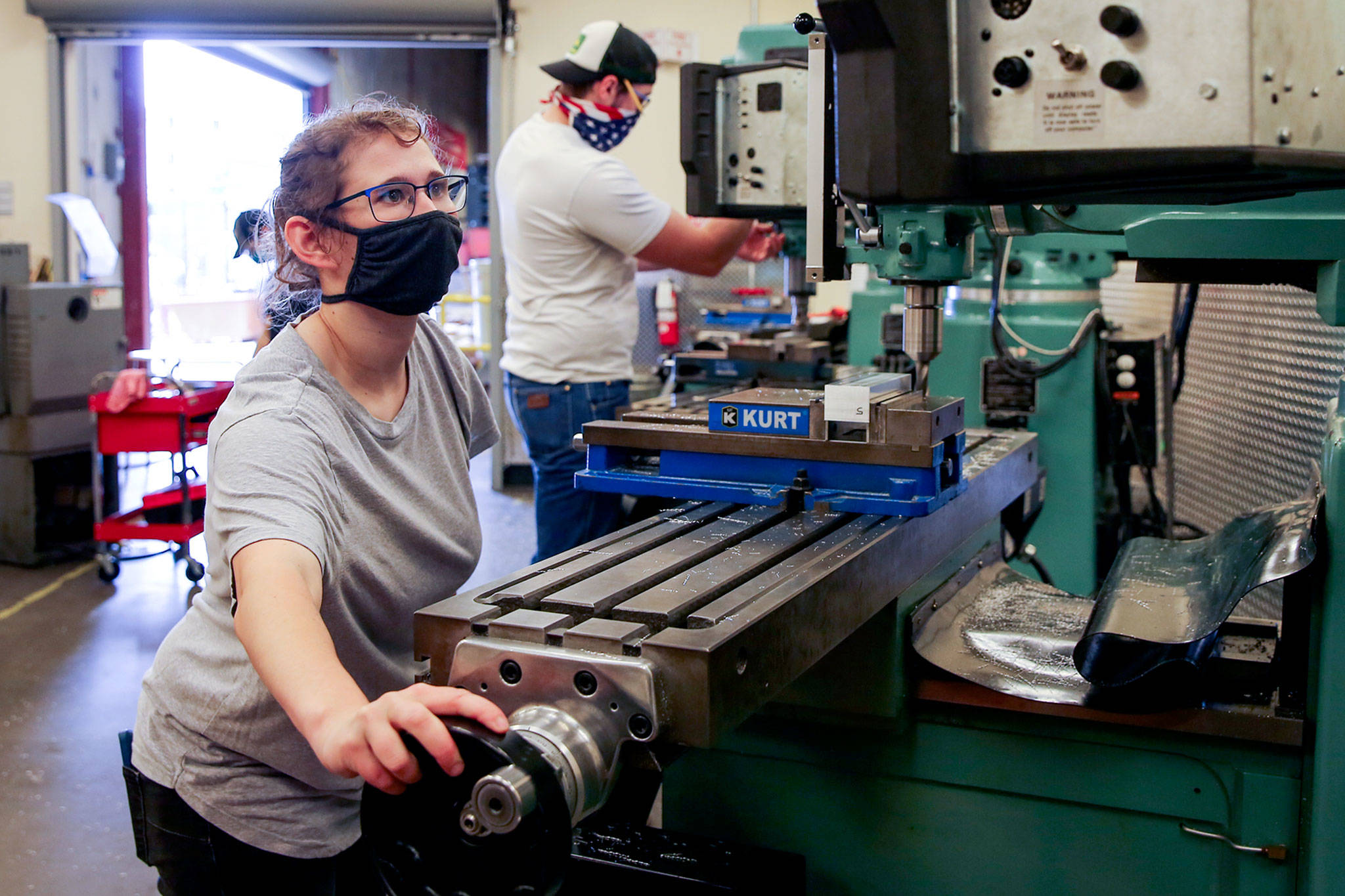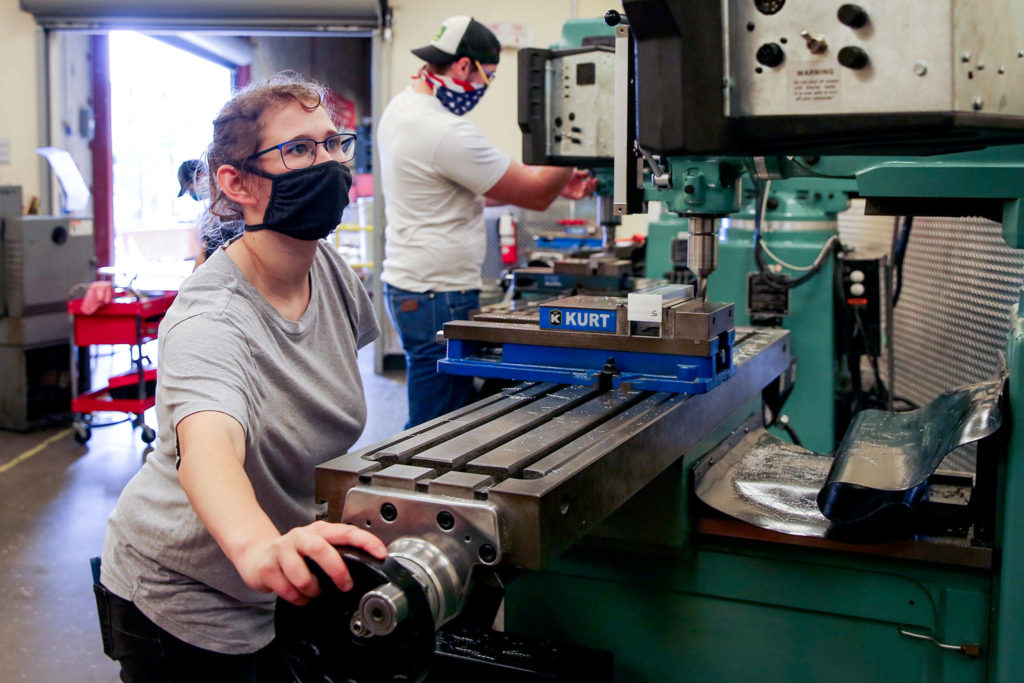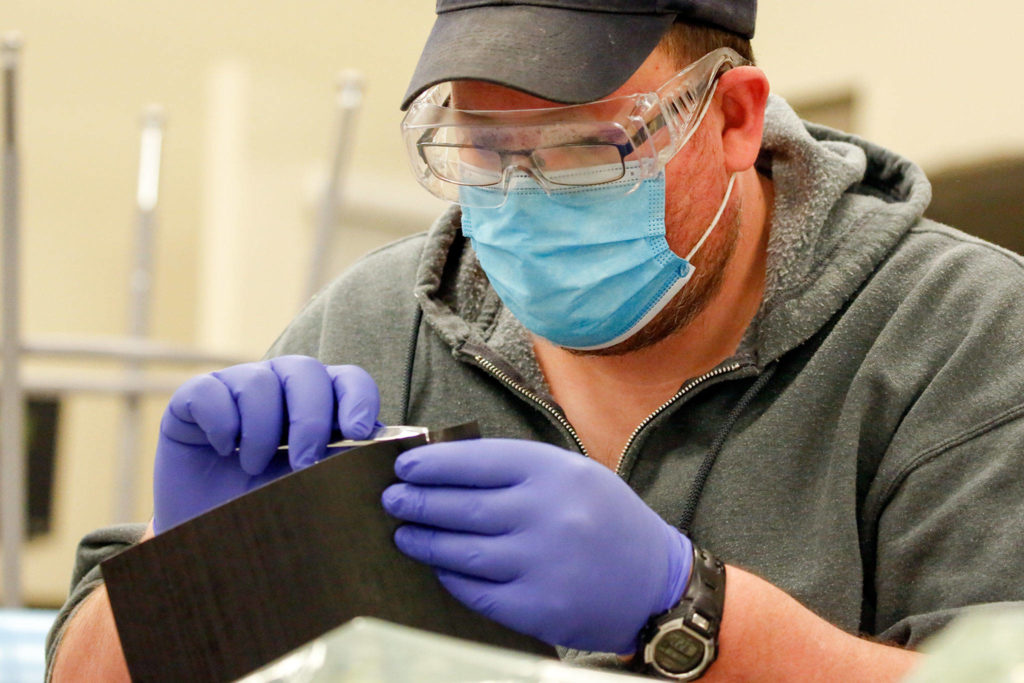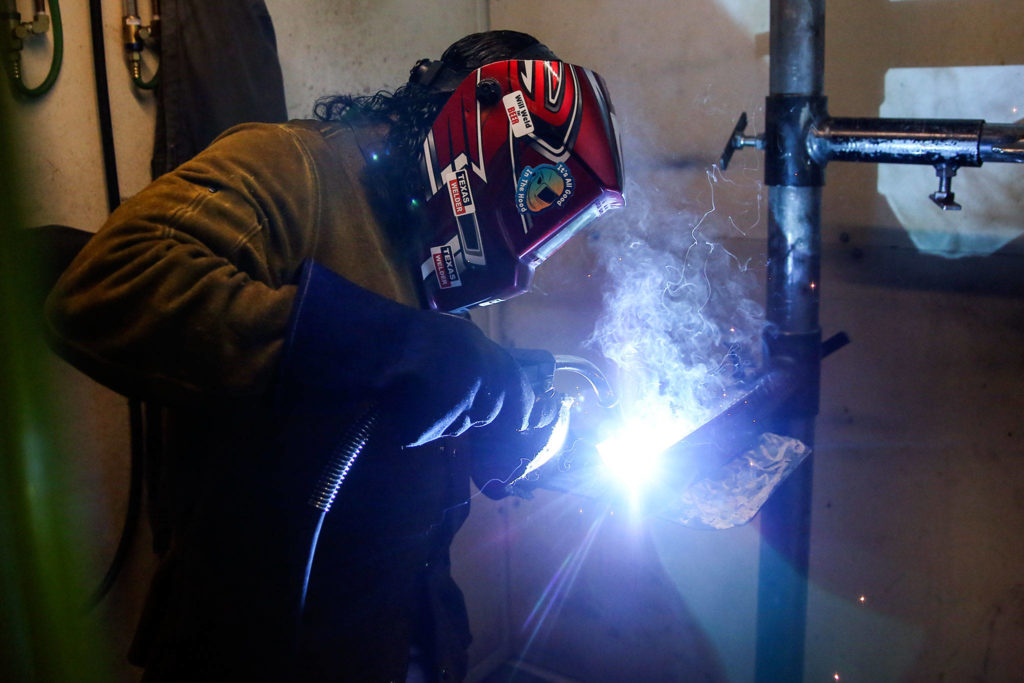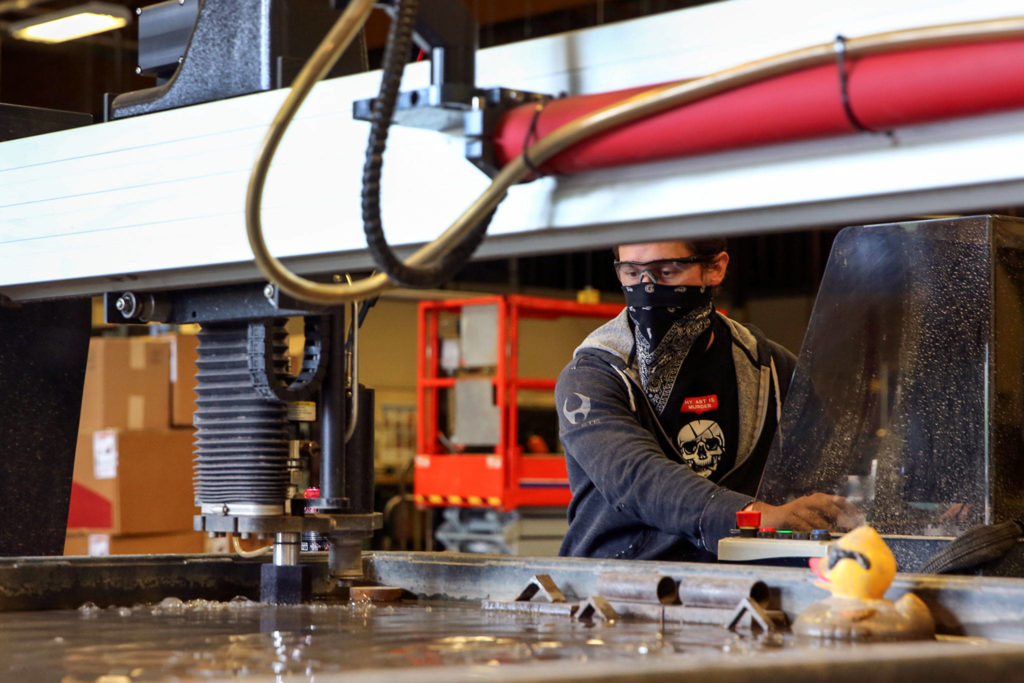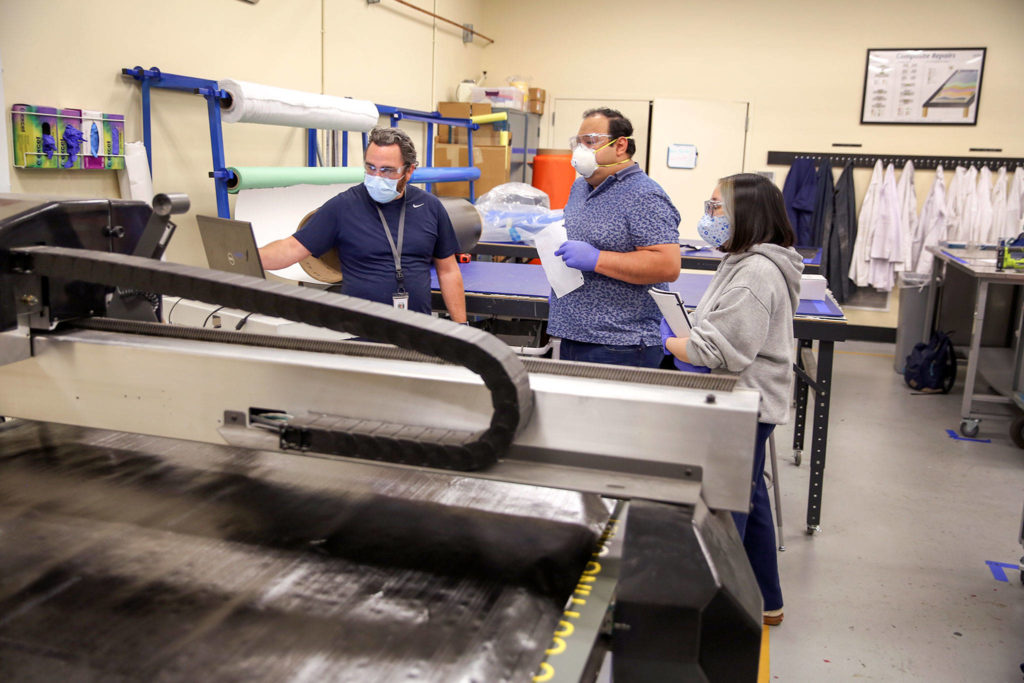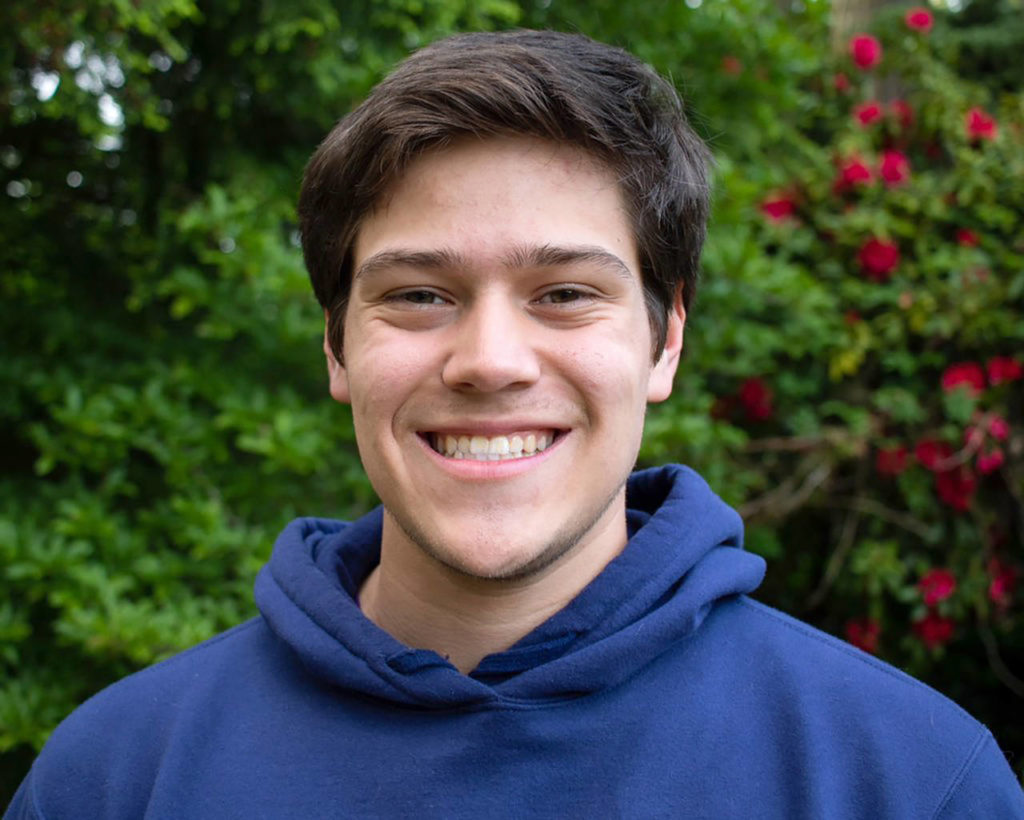EVERETT — Gabe Lopez, 17, got a taste this spring of what it’s like to take an all-virtual college course load.
As the COVID-19 outbreak spread, Everett Community College cleared its campus of students and pivoted to online-only instruction.
Lopez also shifted gears, moving his study area from his room to the downstairs living room.
“I set up my computer on a TV tray,” he said of his quest to find the best in-home wi-fi reception. Lopez, who’ll be a senior this fall at Cascade High School in Everett, takes classes at EvCC through the Running Start program, which allows high school students to take college classes for free.
For a virtual class in public speaking, he leveled his gaze toward the camera on his computer and delivered a speech about Samuel Huntington, one of the signers of the Declaration of Independence.
“I’ve given speeches before and I like to draw my energy from the crowd, so this was a little different,” Lopez said of the onscreen address.
“I think our teachers did a pretty good job teaching online last quarter,” said Lopez. In fact, he’s ready to do it again this fall and plans to enroll in two EvCC classes — anthropology and logic.
What will college campuses and classrooms look like in September? Expect a combination of remote and in-person classes, local college and university officials say.
Fall quarter at Everett Community College, Edmonds College, and fall semester at Washington State University Everett, are shaping up to be a hybrid, a combination of on-campus and virtual classes with safeguards built into the schedule should there be a spike in COVID-19 cases. The University of Washington Bothell also expects to provide online and in-person instruction.
Don’t let the format discourage you from applying or enrolling, officials say. Instructors and staff are ready to help.
Phil Weiler, vice president of marketing and communications for the Washington State University system, has a special message for high school graduates who might be weighing whether to take a year off, a so-called gap year, and delay attending college until 2021: “You might want to reconsider.”
“Gap years are about getting some experience, and working or traveling,” Weiler said. “But this year, travel isn’t happening and it’s questionable what kind of work there is out there. I would argue this isn’t the year to take a gap year.
“It’s not going to be the same experience this fall as last,” said Weiler, “but it’s going to be a high-quality education.”
It’s all about “finding a groove,” said Bryana Shepherd, who returned to college this spring after an 11-year hiatus. Shepherd, 29, feared that an all-online course load might trip her up.
“My first three weeks of classes felt like a nightmare,” said Shepherd, who had to balance study time with taking care of her two children, ages one and seven.
Eventually, Shepherd devised “a study pattern that worked,” she said. It included re-watching video lectures, re-writing her notes and carving out study time when her youngest was napping.
“I don’t feel as if my education has suffered at all due to being online-only,” Shepherd said. “I think the instructors have all handled this hurdle brilliantly and deserve such a huge round of applause.”
Here’s how area colleges are anticipating the near future:
Edmonds College
Amit Singh, president of Edmonds College, said the school’s plan is still evolving but will be in line with state guidelines. However, the hope is “to have a close-to-normal opening — close to what we had last year,” Singh said. That includes a back-up plan if things turn out worse than expected.
All in all, expect a higher percentage of online and hybrid classes.
Instead of showing up three times a week for a class, students might instead visit campus once a week and attend virtually twice a week, said Singh.
Students may have to undergo a quick health screening before class. Masks probably won’t be required.
If you’re hesitant about applying or attending college this fall, don’t be, said Singh.
“We are here for students. We’re making sure we provide the services that we always do,” he said. That includes virtual meetings with academic advisors and financial aid counselors — in fact, “you can do everything from home,” Singh said.
If you’re worried about having a laptop computer, there will be more than 500 laptops available in the fall for check-out.
“We did that for spring quarter and anyone who needed one got one,” Singh said.
Singh said that enrollment at the college could rise in the fall because of COVID-19 related job losses, especially as temporary furloughs turn into permanent layoffs. During previous recessions, when jobs were scarce, college enrollment usually increased.
“This is a good time to go back to school,” Singh said. “Now is the time to boost your skills so you can get a better-paying job. You have to get ready for the future.”
Edmonds College serves about 10,300 students each quarter.
Everett Community College
EvCC will offer three kinds of classes fall quarter — online, livestreamed and hybrid, said John Bonner, interim executive vice president of instruction and student services. “Online classes are all online,” Bonner said. Livestreamed classes are online with class being held at specific times. Hybrid classes will have online lectures and in-person labs.
“For now, the classes that we’re offering with in-person labs include advanced manufacturing, aviation, fire science, nursing, medical assisting, phlebotomy, information technology and some sciences classes,” Bonner said. More programs could switch to on-campus when it’s safe to do so, Bonner said.
Ensuring the safety of students and staff and supporting students through this time is the college’s highest priority, Bonner said.
For that reason, “This fall won’t be the same as last fall because of the steps we’re taking to prevent the spread of the coronavirus,” he said.
Don’t expect a tuition break at EvCC because some classes are online (or for that matter, at Edmonds College, WSU Everett or UW Bothell). EvCC has been offering virtual classes for two decades, since 1999. In fact, many online classes were being taught online prior to the pandemic, Bonner said.
Not sure how to navigate a virtual course?
“We’re well prepared to help our students,” he said.
Programs that require some hands-on learning, such as health sciences, advanced manufacturing and aviation, will follow a hybrid format. The lecture portion will be delivered online. In-person shops and labs will follow strict safety protocols. For example, all faculty, staff and students will be screened each day before coming to class. Tools and equipment will be disinfected after use. And until further notice, face coverings are required.
Faculty have organized classes to ensure at least six feet of social distancing, said Bonner.
Academic and financial aid advisors — and the college’s tutoring staff — are available via email, video chat, text message or phone. Chromebooks are available at no charge.
“We will be with you every step of the way,” said Bonner.
“EvCC has faced tough times before, like when an arsonist destroyed the college’s library and student union and killed an EvCC firefighter in 1987,” Bonner said of the current COVID-19 outbreak.
“One of the only pieces that survived the fire was the Feather Star sculpture, which stands outside of the Parks Student Union and is part of our college’s logo.
“If you look closely at the sculpture, you’ll see the tip of one of the spires is slightly bent from the fire — a lasting reminder that when Trojans get knocked down, we get back up again.”
Washington State University Everett
WSU Everett is still pondering how the fall quarter will unfold, but like other institutions, a combination of online and in-person instruction is where “we’ll probably end up,” said Weiler, vice president for marketing and communications.
The move to online learning wasn’t a big jump — about 60% of faculty had been teaching online before the COVID-19 outbreak, Weiler said.
Most likely? “A hybrid model oriented toward face-to-face, balanced by the need to physically distance, with the ability to transition to remote learning if need be,” Weiler said.
Getting there could mean tweaking the academic calendar and limiting the number of students on campus to help reduce “human bunching between classes,” he said.
To help, the WSU network has enlisted a group of in-house experts.
“We have a lot of faculty members who are experts in disease and infectious disease modeling,” Weiler said.
Students who feel they or their families are in a high-risk category should have some flexibility in terms of on-campus attendance, Weiler said.
Anyone who needs a laptop will be supplied one, said Randy Bolerjack, WSU Everett spokesman.
Face coverings will be required on campus. But take heart — there are some good ones out there, including a mask that depicts a cougar devouring a husky, Bolerjack said.
The WSU network is on a semester system, which could prove advantageous should COVID-19 cases spike in the fall.
Colleges and universities that follow a semester system could start early and end early, sending students home by Thanksgiving. That way, if students or faculty are exposed to the coronavirus, they don’t run the risk of bringing it back to campus after the Thanksgiving break. Seattle Pacific University said this month it plans to start classes two weeks earlier than usual and end two days before Thanksgiving to minimize on-campus presence, a model that WSU is considering.
“The watchword is flexibility,” Weiler said.
WSU expects to share its final plans this month with guidelines for students and staff.
University of Washington Bothell
UW Bothell moved to restricted operations in the spring, with all classes and student services being offered remotely. Only staff and faculty who were deemed critical were allowed on campus.
“The University of Washington is planning to be back this fall for in-person and online instruction and expects to provide specific details in mid-June to early July,” university spokeswoman Maria Lamarca Anderson said in an email.
“At this time, it is anticipated that autumn quarter will include both in-person and remote elements,” Lamarca Anderson said. Some larger classes, for example, could be held online, with smaller sections held in-person with everyone practicing social distancing.
A Back-to-School Task Force is reviewing and updating university protocols to ensure student, faculty and staff health on campuses, including residences, classrooms, labs and libraries, Lamarca Anderson said. Their work is informed by public health experts, including the UW Advisory Committee on Communicable Diseases, Environmental Health & Safety and UW Medicine infectious disease specialists.
Students are advised to check the UW Bothell website for updates.
Janice Podsada; jpodsada@heraldnet.com; 425-339-3097; Twitter: JanicePods
Talk to us
> Give us your news tips.
> Send us a letter to the editor.
> More Herald contact information.
